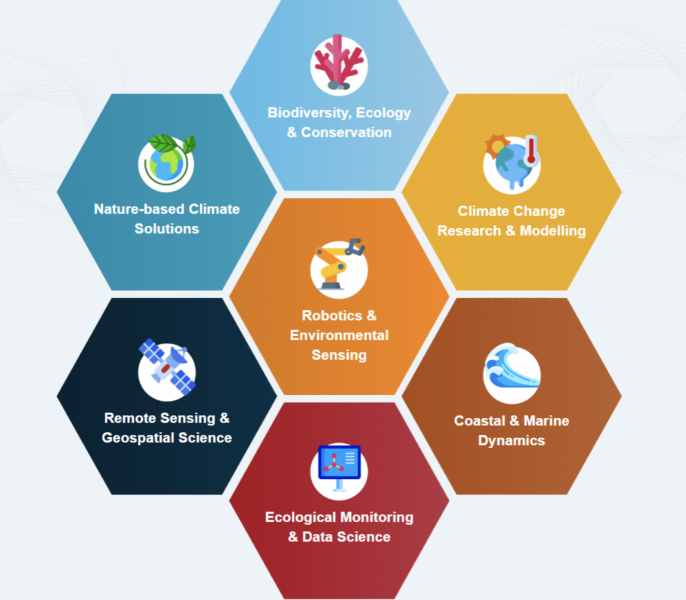Looking to 2023: A Wishlist for Nature in a World on Fire
February 22, 2023
IN BRIEF | 10 min read
- By protecting a forest instead of cutting it down for conversion into an oil palm plantation, for example, the developer of the land can raise revenue through the sale of carbon credits.

| By Professor Koh Lian Pin and Audrey Tan |
If all the world’s a stage in a show on the plight of our planet, then the show-stoppers must be the extreme weather events pummelling the globe. The supercharged typhoons, severe heat waves and destructive floods that took place over the past year or so have made countries sit up and pay attention to the impacts that humans and their appetites for fossil fuels are wreaking. At the COP27 climate change conference in Egypt last year, countries agreed to establish a contentious fund that would compensate developing countries for the “losses and damages” incurred due to climate change. Details still need to be worked out, but given that developed countries were previously opposed to the set-up of such a fund, the outcome signals a global recognition of the worsening impacts of the climate crisis.
But brewing backstage at the “climate show” is another crisis – biodiversity loss. While the impacts of nature in peril are, for now, not as keenly felt as the disasters that have destroyed communities and infrastructure, people are starting to recognise how intimately intertwined the health of nature is with human well-being. A United Nations report published in 2021 noted that half of the world’s gross domestic product is dependent on nature. Other scientific studies, including ones by researchers at the NUS Centre for Nature-based Climate Solutions (CNCS), have also demonstrated the links between protecting nature and the benefits of cleaner water and higher agricultural productivity, among other things. Yet, wildlife species are disappearing at an alarming rate. The planet is undergoing its sixth mass extinction event, and scientists have estimated that one million plant and animal species are on the verge of extinction. Many of them could be gone within a matter of decades. The alarm bells are tolling for biodiversity, and the world responded in December 2022, when nations agreed on a new global biodiversity framework to stem the loss of species.
The biodiversity framework joins the Paris Agreement on climate change as another global pact; and the two will help nations act to tackle the two crises confronting our planet today. Against this backdrop, we highlight a number of developments that could emerge in the year ahead at the biodiversity-climate nexus, and opportunities for research institutions like NUS to make a difference in the effort to tackle climate change and stem the loss of wildlife.
Boosting confidence in carbon markets
Discussions on how to tackle climate change and biodiversity loss would likely converge most strongly in international carbon markets. By protecting a forest instead of cutting it down for conversion into an oil palm plantation, for example, the developer of the land can raise revenue through the sale of carbon credits. In principle, the climate benefit of emissions avoidance projects, such as a forest protection effort, is primarily a function of the amount of carbon a forest contains and the threat of losing that carbon. But problems arise when project developers do not have accurate estimates about the carbon stock in a forest, or misrepresent the threat of deforestation. In January 2023, British news outlet the Guardian published an article that raised questions about the effectiveness of forest protection carbon projects at reducing deforestation. The basis of the article included scientific papers that questioned the methodologies used by Verra, the firm that certifies carbon credits sold by many nature-based carbon projects, in overestimating deforestation risk, resulting in “extra” credits being sold.
The voluntary carbon market has long been mired in controversies over carbon credit quality, and the scrutiny is likely to intensify as the sector grows. Yet, the market for carbon credits provides a unique way of protecting forests in the near-term, since it channels private sector funds to a cause that is usually a drain on national coffers. Put simply, carbon markets offer a solution to ensuring that bastions of wildlife remain standing, an outcome that will also help to limit global warming to well under 2 deg C above pre-industrial levels, a target set out in the Paris Agreement. Scientific institutions such as CNCS can help to strengthen confidence in the carbon market. For example, CNCS last year launched a new research programme, called Carbon Integrity SG, that will help improve estimates of carbon stock in Southeast Asia’s mosaic of natural habitats, from tropical rainforests to peatlands. Researchers at the centre are also looking into different ways that deforestation risk can be assessed in an ongoing study. Robust, peer-reviewed science plays a crucial role in bolstering trust in carbon markets, ensuring that funds flow to the protection of the world’s remaining wild spaces.
A Time for Tropical Oceans
The marine environment would also come into greater focus at international discussions on tackling climate change and biodiversity loss. At last year’s COP27 climate change conference in Egypt, for example, an Ocean Pavilion was erected for the first time to draw attention to how climate change was affecting the oceans. It follows a Special Report on the Ocean and the Cryosphere in a Changing Climate by the Intergovernmental Panel on Climate Change published in 2019, which warned that the ocean is getting warmer, more acidic and less productive. Melting glaciers and ice sheets are causing sea level rise, and coastal extreme events are becoming more severe, the report also said.
For archipelagic Southeast Asia, which has more than 24,000 islands with a population of over 640 million, changes in the marine environment warrant close watching. There are multiple dimensions to how oceanic changes affect the maritime continent. First, marine biodiversity. The Coral Triangle is a hotspot for marine life, and spans Southeast Asian nations such as Indonesia, Malaysia, and the Philippines. But multiple bleaching incidents caused by rising sea surface temperatures could cause coral reefs – important fisheries and ecotourism drivers for many coastal communities – to decline. The spread of invasive species carried through ship ballast water could further threaten the rich marine biodiversity of the region. Second, climate impacts manifesting in the oceans, such as sea-level rise and typhoons, pose a threat for low-lying countries in the region. Third, Southeast Asia’s location between the Pacific and Indian Oceans mean it is susceptible to oceanic-atmospheric phenomena developing in either basin, such as the El Nino Southern Oscillation (ENSO) and the Indian Ocean Dipole (IOD), which could cause changes in rainfall patterns and sea surface temperatures in the region.
The NUS Tropical Marine Science Institute (TMSI), which has over the past few decades been studying the region’s marine biodiversity and developing engineering solutions for coastal protection, can play a crucial role in helping the world understand these challenges, so policymakers can better respond to them.
A Diversity of Actors
Conservation and climate narratives are often dominated by countries in the Global North, but we can expect a greater diversity of actors from the Global South to be involved in these conversations going forward. This is crucial for two key reasons. First, developing countries face the brunt of climate impacts, and they may not always have the capacity to take action to adapt to them. It is important that those most vulnerable to the impacts of climate change and biodiversity loss have a seat at international discussions on these issues, since action – or inaction – would affect them the most. Moreover, the growth of carbon markets and the increasing attention paid to tropical habitats as suppliers of carbon credits may also negatively affect communities such as indigenous peoples, who fear the commodification of nature would lead to land grabbing and the loss of their culture. The global biodiversity framework urges countries to “foster the full and effective contributions of women,

youth, indigenous peoples and local communities, civil society organisations, the private and financial sectors, and stakeholders rom all other sectors” — a signal to all that various viewpoints should be factored in decisions on the fate of the global environment.
Secondly, developing nations can offer solutions too. A United Nations report in 2021 found that between 2006 and 2011, the indigenous territories in the Peruvian Amazon reduced deforestation twice as much as protected areas with similar ecological conditions and accessibility. The social element of forest conservation is an area that researchers at CNCS are starting to look into as well. When it comes to tackling the challenges of climate change and biodiversity loss, context is key. Research institutions from the Southeast Asian region play an important role in interrogating global narratives and contextualising projections for the region. TMSI scientists are, for example, looking into downscaling global climate models so they yield more accurate results for Singapore and the region. Likewise, CNCS’ Carbon Integrity SG study will help finetune pantropical forest models on carbon estimation to the region’s diverse and unique habitats.
Climate change and biodiversity loss are global problems that require all hands on deck, and research institutions such as NUS can contribute to the search for solutions that will benefit climate, nature, and people.
About the Authors
 Professor Koh Lian Pin is the Director of the Centre for Nature-based Climate Solutions (CNCS) and the Tropical Marine Science Institute (TMSI). He is also the Kwan Im Thong Hood Cho Temple Chair Professor of Conservation at NUS, Vice Dean of Research at the Faculty of Science and currently serves as a Nominated Member of Parliament. Prof Koh has 20 years of international research experience in sustainability and environmental science, having worked in institutions across Switzerland, Australia, and the United States. One of the most highly cited conservation scientists in Asia, he is a TED-Global speaker, Founding Director of ConservationDrones.org and a World Economic Forum Young Global Leader.
Professor Koh Lian Pin is the Director of the Centre for Nature-based Climate Solutions (CNCS) and the Tropical Marine Science Institute (TMSI). He is also the Kwan Im Thong Hood Cho Temple Chair Professor of Conservation at NUS, Vice Dean of Research at the Faculty of Science and currently serves as a Nominated Member of Parliament. Prof Koh has 20 years of international research experience in sustainability and environmental science, having worked in institutions across Switzerland, Australia, and the United States. One of the most highly cited conservation scientists in Asia, he is a TED-Global speaker, Founding Director of ConservationDrones.org and a World Economic Forum Young Global Leader.
 Ms Audrey Tan is the Science Communications and Outreach Lead at CNCS and TMSI. A FASS Alumna, Ms Tan (NUS Sociology, '13) has a decade of experience in environmental journalism through her work at Singapore's national newspaper, The Straits Times, and sits on the Pulitzer Centre’s Advisory Committee for the Southeast Asia Rainforest Journalism Fund.
Ms Audrey Tan is the Science Communications and Outreach Lead at CNCS and TMSI. A FASS Alumna, Ms Tan (NUS Sociology, '13) has a decade of experience in environmental journalism through her work at Singapore's national newspaper, The Straits Times, and sits on the Pulitzer Centre’s Advisory Committee for the Southeast Asia Rainforest Journalism Fund.
This story is part of Looking to 2023, an NUSnews series of commentaries on what readers can expect in the new year, and first appeared on NUSnews on 21 February 2023.

